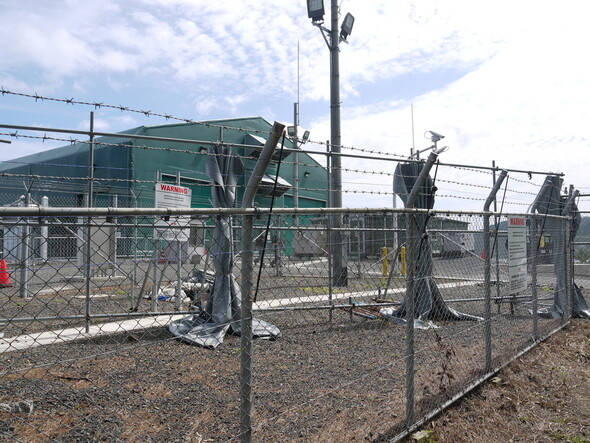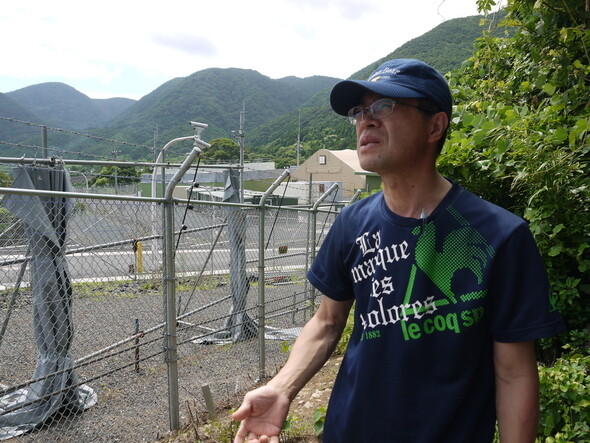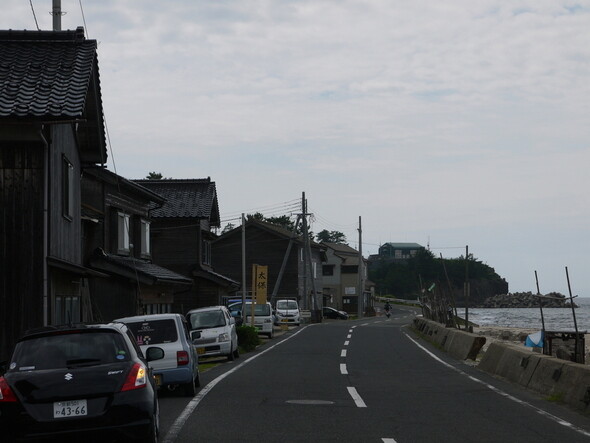hankyoreh
Links to other country sites 다른 나라 사이트 링크
[Reportage] Japanese community with THAAD radar glumly says ‘it’s ok’

I was at Kyogamisaki Communications Site, a US military base in the Japanese city of Kyotango, in Kyoto Prefecture, which is home to an AN/TPY-2 X-band radar. This radar is the linchpin of the US missile defense system called THAAD (Terminal High Altitude Area Defense).
The area around the base looked much the same as when I visited a year ago. As I drove east along Highway 178, leading to the base, the waters of the East Sea stretched out to the north. Suddenly I was driving past barbed wire fence that cradled the US military’s communications antenna, which looked much like a giant soccer ball.
Beyond the green building on the northernmost point of the base was the X-band radar, whose very presence has wide-ranging ramifications for affairs in East Asia.
One 84-year-old man who was born and raised in Sodeshi Village - located about 500m east of the entrance to the base - recalled that the generator used to operate the radar had put the village in an uproar at first, but that things had largely quieted down now.

My eardrums were bombarded with a mixture of the loud rumble of the generator and the waves crashing against the breakwater near the village.
“We used to have trouble getting to sleep [because of the noise], but we’ve gotten used to it over the past two years,” said the man’s 77-year-old wife, who showed up as we were talking. The couple had nothing more to tell me.
“When the wind blows from the west, it gets a little noisier,” said Shojo Nakamura, 76, who works in a warehouse in front of the entrance to the base. “There used to be people who said they had trouble sleeping at night.”
After South Korea’s Defense Ministry announced on July 13 that the US military would be installing a THAAD battery in Seongju County, North Gyeongsang Province, South Korean society’s attention has been focused on this small seaside village in Kyoto, Japan. Concerns about the effect of the electromagnetic waves emitted by a radar identical to the one here are dividing South Korean public opinion.
In June of last year, when South Koreans first started talking about THAAD, I came here to report on residents who were concerned about the noise and the health effects of the electromagnetic waves.
At the time, there was considerable opposition from residents who were afraid that their health would be damaged by the radar, but over the past year, the residents appear to have come to terms with the radar, like it or not.

The decision to deploy the radar was made abruptly in Japan, just as in South Korea. On Feb. 22, 2013, Japanese and American leaders announced that they had decided to install another X-band radar in Japan to respond to the threat posed by North Korea’s nuclear and missile programs. Japan’s first radar station had been set up in Shariki, Aomori Prefecture, in June 2006.
The deployment decision had been unilateral, without any communication with locals.
But in Japan, thousands of protestors did not join huge demonstrations in opposition to the radar as they have in Seongju. After the decision to deploy the radar was made in Feb. 2013, the Japanese Ministry of Defense fielded four rounds of sharp questions from local governments - including Kyotango and Kyoto Prefecture - about the suitability of installing the radar and about ways to deal with potential problems.
In documents containing these questions that the Hankyoreh reviewed on July 17, the questions the local governments were most concerned about were why the radar had to be installed there and whether it would really contribute to Japan’s security.
In the face of repeated questions, the Japanese government offered the same answer, that the data collected by this radar would be combined with data from radars operated by the Japanese Self-Defense Forces and shared in real time [between Japan and the US]. This makes it possible for ballistic missiles that are fired at Japan to be detected and tracked with greater accuracy and precision, the government said.
As for why the radar needed to be installed at Kyogamisaki in Kyotango, the Japanese government offered a number of reasons: it was a location from which ballistic missiles heading for Japan or the US could be detected and tracked; there were no obstacles there that would block the radar; and there was nothing in the area likely to interfere with the radar waves.
Since the Japanese government had decided to participate in the American missile defense system in Dec. 2013, there was already a domestic consensus that installing the radar would help bolster US and Japanese missile defense. Thus, the strategic situation was completely different from South Korea, in which the deployment of THAAD is currently part of the “great game” between the US and China.
To be sure, debate about the safety of the radar has continued in Japan, just as in South Korea. In this respect, the circumstances of the deployment were less problematic in Japan than in South Korea. The radar in Kyogamisaki is facing north, which means the radar waves are aimed at the ocean - which is not the case in Seongju.

These facts were what Kyoto University professor Toru Sato and other researchers had in mind when they submitted an opinion paper to Kyoto Prefecture in July 2013. “The X-band radar has a heating effect on objects in front of it. Safety can be guaranteed by creating an off-limits area in front of the radar,” Sato wrote in the paper.
Sata’s point was that, though there is no telling what effect the radar would have on the human body, in Kyogamisaki it would be adequate to set up an off-limits area in front of the radar since the radar was facing the ocean. This is not comparable with Seongju, where tens of thousands of people are living two kilometers in front of the radar.
In Japan, the social controversy about installing the radar was ultimately reduced to the technical issues of how to deal with the noise from the generator and problems caused by US soldiers and contractors.
After repeated complaints by locals about the noise, the US military installed a muffler on the generator in Feb. 2015. There is a plan to resolve the noise for good in 2017 by bringing in electricity from Kansai Electric Power Company.
What was particularly striking is the administrative action taken by the Japanese central government. After deciding to install the radar in Feb. 2013, the Japanese government organized a grand total of 12 informational hearings for locals. Instead of expropriating the land for the US military to use, they arranged rental contracts with the landowners that were much more lucrative than the market price.
The government also decided to provide a total of 3 billion yen (US$28.44 million) in grants to Kyotango, and at the end of 2014 it created a deliberative body - called the Safety and Security Meeting - that would bring together representatives from the Japanese government, the US army and the local community to discuss issues related to the base.
On the website of Kyoto Prefecture, there are documents available containing actual measurements of the noise around the base and the electromagnetic waves that the radar emits. To be sure, since all of these documents state that nothing is wrong, some people are dissatisfied and don’t trust the Defense Ministry’s data.
This does not mean, of course, that the residents have all come around in support of the radar installation.
“It’s not like anyone would like the fact that they’ve built this kind of facility. We’re just quiet because voicing our grievances won’t change the government‘s mind. There are differences between the ways that Koreans and Japanese express themselves,” said Geichi Yamaguchi, a 61-year-old resident of Sodeshi Village.
While I went around Sodeshi Village and nearby Uwa Village and asked a dozen or so locals about the issue, there were few who were willing to candidly express their opinions. Most of them repeated characteristically Japanese expressions of resignation, such as “It’s fine”; “You can’t do anything about the government”; and “No use crying over spilt milk.”
“The negative effect of the radar is invisible,” said Munenori Owan, 75, co-chairman of the Kyoto Group Against the X-Band Radar Base. “Electromagnetic waves are invisible, and the effect of the noise varies with the individual. If I’m having problems and the person next to me is fine, that makes me the weird one.”
“If South Korea teams up with the US against China, South Korea won‘t be able to prosper. Security problems must be resolved through dialogue and not through military conflicts that antagonize the other side. Focusing solely on electromagnetic waves and noise will make you miss the heart of the problem,” Owan said.
Sodeshi Village is weighed down by a sense of despair and discontent that is drowned out by the ominous rumble of the generator. Is this the future that the South Korean government wants for Seongju?
By Gil Yun-hyung, Tokyo correspondent in Kyotango
Please direct questions or comments to [english@hani.co.kr]

Editorial・opinion
![[Guest essay] The real reason Korea’s new right wants to dub Rhee a founding father [Guest essay] The real reason Korea’s new right wants to dub Rhee a founding father](https://flexible.img.hani.co.kr/flexible/normal/500/300/imgdb/original/2024/0423/8317138574257878.jpg) [Guest essay] The real reason Korea’s new right wants to dub Rhee a founding father
[Guest essay] The real reason Korea’s new right wants to dub Rhee a founding father![[Column] ‘Choson’: Is it time we start referring to N. Korea in its own terms? [Column] ‘Choson’: Is it time we start referring to N. Korea in its own terms?](https://flexible.img.hani.co.kr/flexible/normal/500/300/imgdb/original/2024/0423/3617138579390322.jpg) [Column] ‘Choson’: Is it time we start referring to N. Korea in its own terms?
[Column] ‘Choson’: Is it time we start referring to N. Korea in its own terms?- [Editorial] Japan’s rewriting of history with Korea has gone too far
- [Column] The president’s questionable capacity for dialogue
- [Column] Are chaebol firms just pizza pies for families to divvy up as they please?
- [Column] Has Korea, too, crossed the Rubicon on China?
- [Correspondent’s column] In Japan’s alliance with US, echoes of its past alliances with UK
- [Editorial] Does Yoon think the Korean public is wrong?
- [Editorial] As it bolsters its alliance with US, Japan must be accountable for past
- [Guest essay] Amending the Constitution is Yoon’s key to leaving office in public’s good graces
Most viewed articles
- 1[Guest essay] The real reason Korea’s new right wants to dub Rhee a founding father
- 2Terry Anderson, AP reporter who informed world of massacre in Gwangju, dies at 76
- 3[Column] ‘Choson’: Is it time we start referring to N. Korea in its own terms?
- 4Why Korea shouldn’t welcome Japan’s newly beefed up defense cooperation with US
- 5[Column] The clock is ticking for Korea’s first lady
- 6Opposition calls Yoon’s chief of staff appointment a ‘slap in the face’
- 7New AI-based translation tools make their way into everyday life in Korea
- 8[Editorial] Japan’s rewriting of history with Korea has gone too far
- 9[Reporter’s notebook] Did playing favorites with US, Japan fail to earn Yoon a G7 summit invite?
- 10[Column] The president’s questionable capacity for dialogue